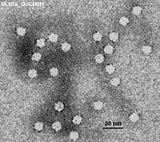
Canine minute virus
Encyclopedia
Canine minute virus is a type of virus
of the family Parvoviridae
that infects dog
s. It is most similar to bovine parvovirus
in its protein
structure and DNA
. A virus causing respiratory disease in humans has been called human bocavirus
due to its similarity to both these viruses (bovine canine virus). Canine minute virus was originally discovered in Germany in 1967 in military dogs, although it was originally thought to not cause disease. Dogs and puppies are infected orally, and the virus is spread transplacentally to the fetuses. Symptoms are seen most commonly between the ages of one to three weeks and include severe diarrhea
, difficulty breathing, and anorexia
. In severe cases it is fatal.
In experimental infections, the virus is spread transplacentally when the dam
is infected between 25 and 30 days of gestation and can result in abortion. When the dam is infected between 30 and 35 days, the puppies were sometimes born with myocarditis
and anasarca
. Pathological
lesions in fetuses in experimental infections were found in the lung
and small intestine
.
Virus
A virus is a small infectious agent that can replicate only inside the living cells of organisms. Viruses infect all types of organisms, from animals and plants to bacteria and archaea...
of the family Parvoviridae
Parvoviridae
The Parvoviridae family includes the smallest known viruses, and some of the most environmentally resistant. They were discovered during the 1960s and affect vertebrates and insects...
that infects dog
Dog
The domestic dog is a domesticated form of the gray wolf, a member of the Canidae family of the order Carnivora. The term is used for both feral and pet varieties. The dog may have been the first animal to be domesticated, and has been the most widely kept working, hunting, and companion animal in...
s. It is most similar to bovine parvovirus
Bovine parvovirus
Bovine parvovirus , also known as Haemadsorbing Enteric Virus, is a member of the parvivirus group, with three significant sub-species: BPV1, 2 and 3. BPV most commonly causes diarrhoea in neonatal calves and respiratory and reproductive disease in adult cattle. The distribution of the virus is...
in its protein
Protein
Proteins are biochemical compounds consisting of one or more polypeptides typically folded into a globular or fibrous form, facilitating a biological function. A polypeptide is a single linear polymer chain of amino acids bonded together by peptide bonds between the carboxyl and amino groups of...
structure and DNA
DNA
Deoxyribonucleic acid is a nucleic acid that contains the genetic instructions used in the development and functioning of all known living organisms . The DNA segments that carry this genetic information are called genes, but other DNA sequences have structural purposes, or are involved in...
. A virus causing respiratory disease in humans has been called human bocavirus
Human bocavirus
Human bocavirus is a parvovirus that has been suggested to cause human disease. It is a probable cause of lower respiratory tract infections and it has been linked to gastroenteritis, although the role of this emerging infectious disease in human disease has not been firmly established.- History...
due to its similarity to both these viruses (bovine canine virus). Canine minute virus was originally discovered in Germany in 1967 in military dogs, although it was originally thought to not cause disease. Dogs and puppies are infected orally, and the virus is spread transplacentally to the fetuses. Symptoms are seen most commonly between the ages of one to three weeks and include severe diarrhea
Diarrhea
Diarrhea , also spelled diarrhoea, is the condition of having three or more loose or liquid bowel movements per day. It is a common cause of death in developing countries and the second most common cause of infant deaths worldwide. The loss of fluids through diarrhea can cause dehydration and...
, difficulty breathing, and anorexia
Anorexia (symptom)
Anorexia is the decreased sensation of appetite...
. In severe cases it is fatal.
In experimental infections, the virus is spread transplacentally when the dam
Mother
A mother, mum, mom, momma, or mama is a woman who has raised a child, given birth to a child, and/or supplied the ovum that grew into a child. Because of the complexity and differences of a mother's social, cultural, and religious definitions and roles, it is challenging to specify a universally...
is infected between 25 and 30 days of gestation and can result in abortion. When the dam is infected between 30 and 35 days, the puppies were sometimes born with myocarditis
Myocarditis
Myocarditis is inflammation of heart muscle . It resembles a heart attack but coronary arteries are not blocked.Myocarditis is most often due to infection by common viruses, such as parvovirus B19, less commonly non-viral pathogens such as Borrelia burgdorferi or Trypanosoma cruzi, or as a...
and anasarca
Anasarca
Anasarca, also known as "extreme generalized edema" is a medical condition characterised by widespread swelling of the skin due to effusion of fluid into the extracellular space....
. Pathological
Pathology
Pathology is the precise study and diagnosis of disease. The word pathology is from Ancient Greek , pathos, "feeling, suffering"; and , -logia, "the study of". Pathologization, to pathologize, refers to the process of defining a condition or behavior as pathological, e.g. pathological gambling....
lesions in fetuses in experimental infections were found in the lung
Lung
The lung is the essential respiration organ in many air-breathing animals, including most tetrapods, a few fish and a few snails. In mammals and the more complex life forms, the two lungs are located near the backbone on either side of the heart...
and small intestine
Small intestine
The small intestine is the part of the gastrointestinal tract following the stomach and followed by the large intestine, and is where much of the digestion and absorption of food takes place. In invertebrates such as worms, the terms "gastrointestinal tract" and "large intestine" are often used to...
.

